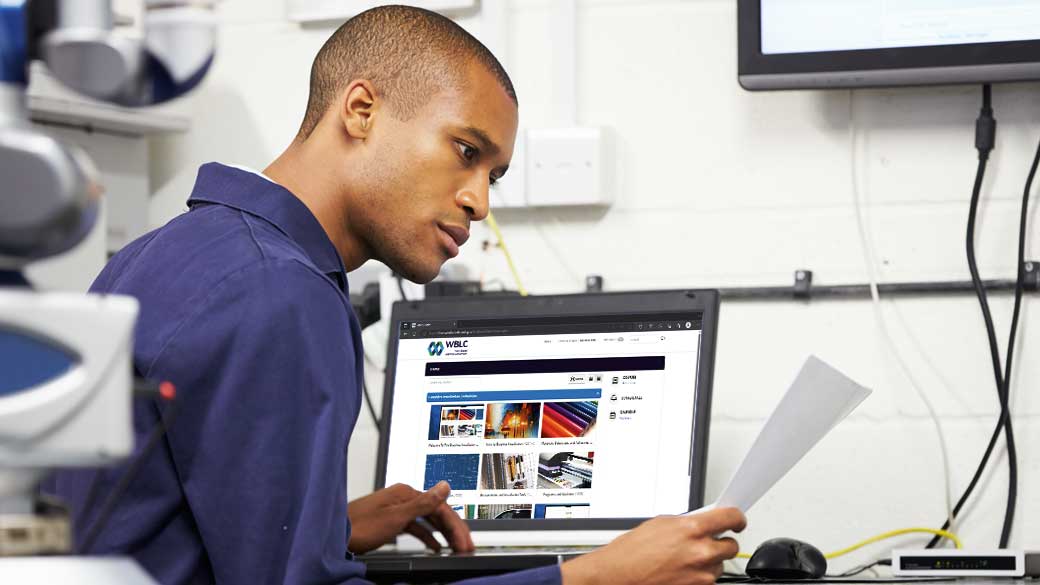It’s fascinating to hear different people’s perspectives on, and experience with, e-learning. Some see e-learning as having a positive impact on industries looking to attract young talent. It’s also playing a key role in upskilling mid-career workers who have been displaced and can play a role in certification of skilled workers.
“Good e-learning has always been welcome,” explains Reema Duggal, a lead for the virtual learning initiatives with Work-Based Learning Consortium (WBLC). “E-learning has been around for a long time. There has always been great e-learning and there’s also been some forms of e-learning that are poorly executed. We’ve been building upon best e-learning practices, focused on learning, competency and driving discussion as well as interaction.”
WBLC has developed a hybrid approach to e-learning, which means having e-learning at the core, and layering in other elements around the core to build a more comprehensive approach. WBLC’s learning programs typically include interactive e-learning, e-instructions, train the technical trainer, shop floor hands-on assignments, technical language training, on-the-job training, monitor coaching and certification.
Earlier this year, the Sign Association of Canada turned to WBLC for a new hybrid learning solution to support training Graphics Installation Technicians. Graphics installation technicians often create and apply large signage to cars, trucks, buses, and any large object, up to and including buildings.
The Sign Association of Canada is working with its members to expand their workforce to meet growing demand. They’re looking to attract young creative talent to the industry as well as people who have been impacted by workforce changes and are looking to upskill into a well-paying career job.
Attracting Youth to a Growing Industry

“Employees today are expecting more e-learning – the way we learn has changed.” – Karin Eaton, Executive Director of the Sign Association of Canada.
“We are an industry looking to attract young talent as well as people who want to reskill because of workforce changes. There are great opportunities for people who want a job in a different industry. How do they make that transition? Education is key,” says Karin Eaton, Executive Director of the Sign Association of Canada.
Eaton explains that education has been always one of the key strategic topics of importance.
“Employees today are expecting more e-learning – the way we learn has changed,” adds Eaton. “Especially the younger generation, they have spent 2-1/2 years learning on Zoom because they weren’t allowed to go into schools during the pandemic. E-learning is becoming more acceptable and new technologies exist to help facilitate it, wherever you are.”
“We have members everywhere (e.g., from Humboldt to St John’s, Kamloops, Moncton, Sudbury and more) in virtually every small or large city or town. So, what is important to our association is that we provide value to all our members regardless of whether you are in a huge community, with lots of opportunities and colleges, or whether you are in a much more remote location. The new, hybrid e-learning could potentially be an important new tool for us and our members,” adds Eaton.
Consequently, the association has embarked on a Graphics Installation Technicians learning program involving 10 companies from coast-to-coast to evaluate this new form of training.
“I’m just excited about e-learning – not just in sign manufacturing, but just in manufacturing in general. I’ve been having a lot of discussions with affiliates in the U.S., and you sometimes wonder ‘is this a Canadian question’ or local question, but you realize the issue is everywhere, and this approach could be part of the solution,” says Eaton.
Upskilling and Training Mid-career Workers
WBLC also worked with the Federal government to examine the impact of e-learning programs on mid-career workers.
“The Future Skills Centre at one point approached us very focused on mid-career workers,” says Rod Jones, Managing Director of WBLC. “Their interest was to see whether or not workers, who had either been displaced or were at risk of being displaced in their current job situation, could transition into a new job situation and acquire the skills needed.”
Jones says the WBLC team was focused on whether mid-career people between 30 to 55 years of age, who had lost a job would, respond to this type of training. Would those people be amicable and comfortable with an e-learning environment? How would they adapt? Would they be comfortable with this kind of technology?
WBLC quickly discovered that it was a very effective tool for mid-career workers in transition as well as for experienced workers who hadn’t set foot in a school in 20, 30 or 40 years.
“The important thing is that our hybrid e-learning works, and it is effective with a wide range of workers,” adds Jones. “It was satisfying their needs and interests and has proven to be attractive to a wide range of job seekers and learners.”
The e-learning modules created by WBLC are very engaging and very different from what students experienced during online classroom instruction during the pandemic.
“You can’t be a talking head,” says Rod Jones, Managing Director of WBLC. “It’s not just filming a classroom instructor. It has to have animation, be interactive and more to make the learning experience engaging. At the core, the e-learning has to be focused on the knowledge and skills that they are required to learn in order to perform the job well and successfully.”
Reema Duggal adds, “With blended learning, the idea is that it’s not just one thing, but it’s multiple techniques that come together to create a highly effective learning program. Our material is highly visual: it’s images, video, 2D and 3D animation, CGI avatars and many other elements. We’re doing all we can to help people learn the material and create a solid understanding of each topic.”
Jones says the key to success is to first clearly define the desired learning outcomes. Then, build robust e-learning programs that pass along the knowledge and skills that are required for a successful performance on the job. It has to be a managed and guided process for people to work through.
Why Companies Want Existing Staff to Also Take This Training
“We’ve had some pleasant surprises that have come from companies that have engaged with us on our e-learning and hybrid approach to training,” says Jones. “A number of companies have told us that they want all of their people on the shop floor to take the e-learning program. Why? Because it is a way of ensuring that all of their staff then use the same language and operate from the same knowledge base. They’re upskilling whole groups of people and upleveling the performance of their workforce. It can really give them a competitive advantage.”
Building New Blended e-Learning Programs
WBLC has been creating blended e-learning programs for a wide range of companies across the country.
“One fascinating element is that virtually every company we have worked with, this has been their first experience with e-learning for employees,” says Jones. “The results of the e-learning have been a differentiator for these companies. We’ve consistently followed a disciplined approach of first defining learning outcomes then deploying our training based upon a proven framework for capturing these outcomes.”
Jones says WBLC has consistently seen strong results – a rapidity of learning and application on the shop floor, improved employee retention and increased trainee satisfaction.

